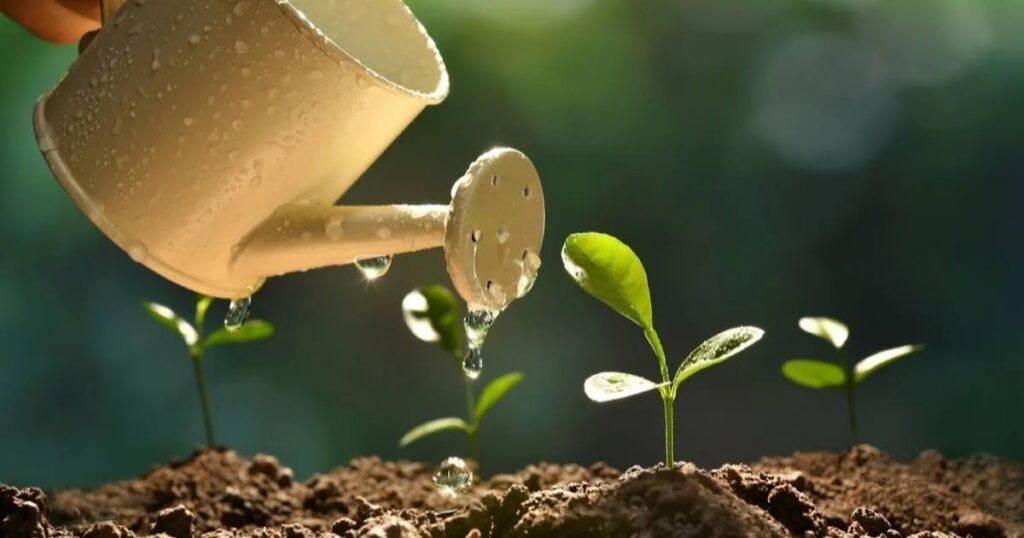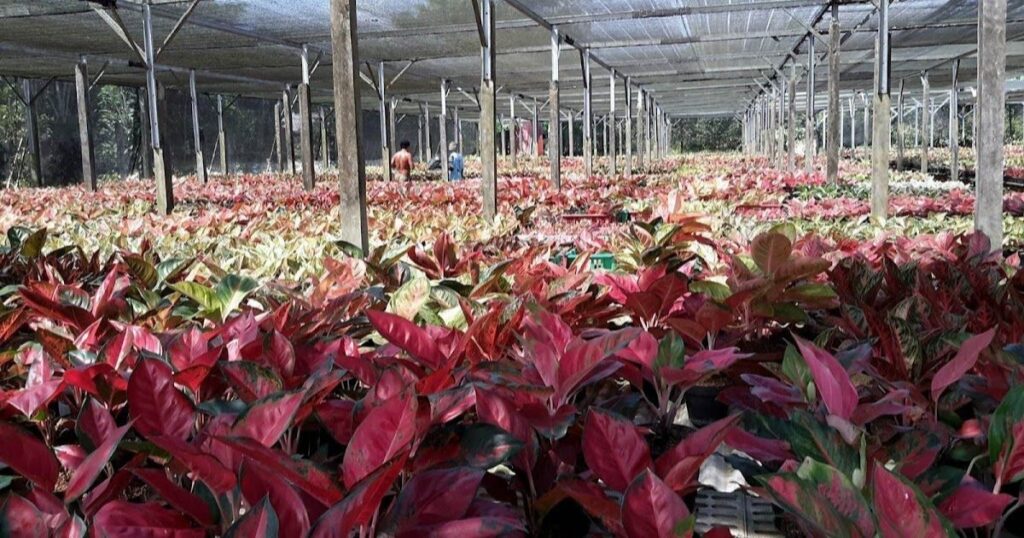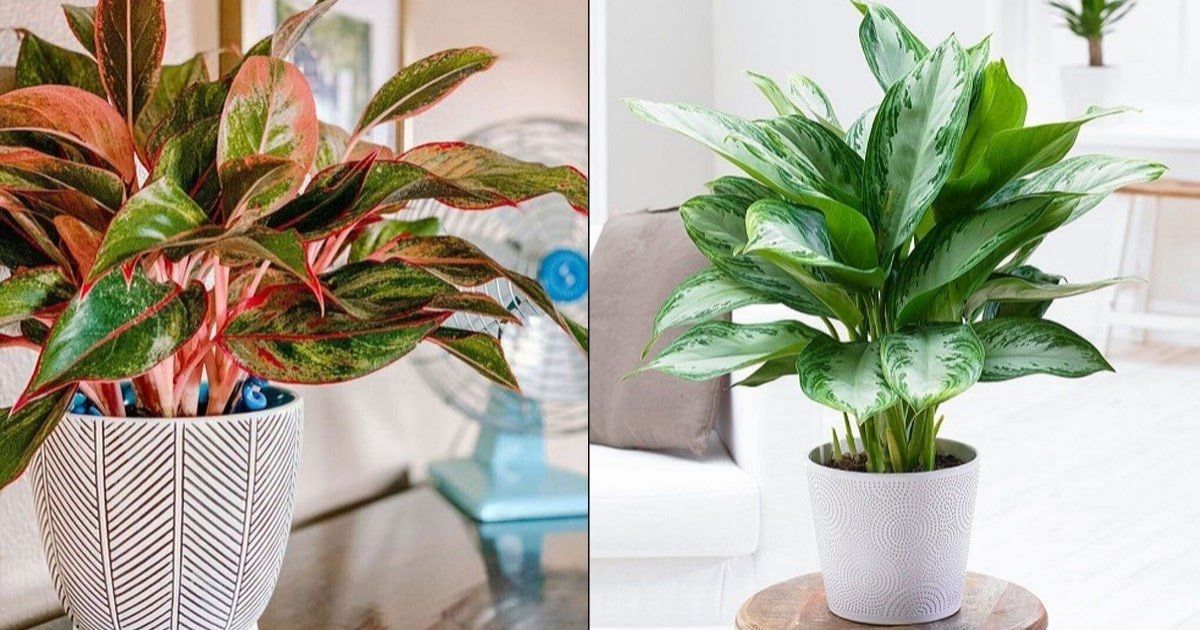The Chinese Evergreen, also known as aglaonema pink, is a striking and popular houseplant that is beautiful and easy to care for. However, it is important to know how to properly take care of your aglaonema pink to ensure that it thrives.
This article will review everything you need to know about caring for your Chinese Evergreen. We will cover topics such as watering, light requirements, soil type, and more. By the end of this article, you will be an expert on properly taking care of your aglaonema pink.
You can make Aglaonema Pink care easy with self-watering pot. Aglaonemas are relatively low-maintenance plants, but they can still benefit from the consistent moisture and reduced water stress that a self-watering pot can provide.
So, if you are ready to learn about aglaonema pink care, let’s begin.
How to Care for Your Aglaonema Pink Plant
Caring for an Aglaonema Pink plant is relatively easy and straightforward. Here are some tips for caring for your Aglaonema Pink plant.
Also read this post:Monstera Gardening
Light
One of the most important factors to consider when growing Aglaonemas is light. The Aglaonema Pink plant can tolerate low to medium light conditions. However, it prefers bright, indirect light. Avoid direct sunlight, as it can scorch the leaves.
Natural Light Requirements: Aglaonema plants thrive in well-lit areas with bright, indirect sunlight. A window with eastern or western exposure is the ideal location for your Chinese Evergreens.
However, direct sunlight can cause the leaves to burn, so avoid placing your Aglaonema in a south-facing window. If your plant receives too little light, the leaves will lose their variegation and become solid green. However, Aglaonemas can tolerate low-light areas such as bathrooms and bedrooms.
Artificial Light Requirements: If you plan to grow Aglaonema plants in an office or other indoor space with limited natural light, artificial or fluorescent light can provide adequate lighting for the plants to thrive.
An office collection of six or more different Aglaonemas can be an excellent way to provide adequate light levels for your plants. You can rotate the plants around the office, switching with your coworkers every few weeks, so the plants get different light levels.
Determining Light Requirements by Leaf Color: The best way to determine the appropriate light levels for your Aglaonema plant is by considering the color of its leaves. If you notice the leaves losing their variegation, turning yellow, or dropping off, it’s a sign that the plant isn’t getting enough light.
Temperature
There is one very crucial factor to consider when you are growing Chinese Evergreen trees, and that is the temperature.
Avoid Cold Rooms and Drafts: Since Chinese Evergreens are sensitive to cold temperatures and breezes, it is important to avoid placing them in cold rooms or areas with cold breezes.
If your plant is exposed to low temperatures for an extended period, it can cause the plant to become stressed and sulk. Furthermore, if your plant is cold and wet, it can create optimal conditions for root rot.
Ideal Temperature Range: The ideal temperature range for Chinese Evergreens is between 70-85°F (21-29°C). It’s essential to avoid exposing the plant to temperatures below 60°F (16°C), especially for extended periods. If you notice that your plant is exposed to cool temperatures, move it to a warmer room to prevent damage.
Avoid Heating and Cooling Vents: Chinese Evergreens should be kept away from heating or cooling vents that can cause extreme temperature fluctuations. If the plant is exposed to hot or cold air blasts, it can cause the leaves to dry out and become damaged.
Avoid Drafty Windows and Doors: Drafty windows and doors are another factors to consider when growing Chinese Evergreens. These can cause rapid temperature fluctuations that can be harmful to the plant. Make sure to keep the plant away from drafty areas to maintain a consistent temperature.
Watering

Proper watering is essential for the health and growth of your Aglaonema plant. This section will discuss the best watering practices for Aglaonema plants, including watering frequency, the importance of drainage holes, and self-watering planters.
Watering Frequency: When watering your Aglaonema plant, thoroughly water it. Water should be applied to the entire soil surface area of the pot, and excess water should drain out through the drainage holes. You should only water your plant when the soil’s top 1-2 inches has dried. Overwatering can cause root rot, which can be fatal to your plant.
Importance of Drainage Holes: Having drainage holes in your Aglaonema pot is crucial to allow excess water to drain out. Without proper drainage, your plant’s roots will sit in water, leading to root rot and eventual death of the plant. Drainage holes help to ensure that your plant’s roots stay healthy and dry.
Self-Watering Planters: A self-watering planter may be an excellent option if you struggle to water your plants regularly. Self Watering Pots for Indoor Plants with Water Indicator (Clear Insert) work by providing a reservoir of water at the bottom of the pot, which slowly releases water to the plant’s roots.
This method ensures that the plant stays evenly hydrated without the risk of overwatering or underwatering. If you are looking for a self-watering planter for your Aglaonema plant, Planterhoma is a great place to start.
They offer a variety of self-watering planters in different sizes and styles to fit your décor. These planters provide a simple and efficient way to keep your plant hydrated without the risk of overwatering or underwatering.
With a self-watering planter from Planterhoma, you can enjoy the beauty of your Aglaonema plant without the hassle of constant watering.
Humidity
Aglaonema Pink plants thrive in environments with higher humidity levels, and one way to achieve this is by placing the plant on a tray of pebbles filled with water. This will help increase the humidity around the plant and create a more comfortable environment for it to grow.
It’s also important to keep your Aglaonema Pink in a temperature range of 65-75°F and avoid drafty areas. During winter, temperatures below 60°F should be avoided as they can negatively impact the plant’s growth and overall health.
By providing the ideal temperature and humidity levels, your Aglaonema Pink will flourish and become a beautiful addition to your indoor space.
Fertilizer
Fertilize the Aglaonema Pink plant once every 2-3 months during the growing season. To ensure that your Aglaonema plant is healthy and thriving, it’s important to fertilize it regularly.
A balanced fertilizer with equal NPK values is ideal for Aglaonemas, as it provides a good mix of nutrients that contribute to the plant’s overall health. However, if you want to focus on promoting healthy leaves and stems, a fertilizer slightly higher in nitrogen can be beneficial.
Another option is to use a houseplant-specific fertilizer designed specifically for indoor gardens. These fertilizers are formulated with the nutrients that indoor plants need to thrive, making them a great choice for your Aglaonema plant.
Repotting
One of the most important aspects of caring for Aglaonema is repotting. Repotting your Aglaonema plant every 2-3 years can help ensure its continued growth and health.
Here is a step-by-step guide on how to repot your Aglaonema plant.
Choose a new pot: Select a new pot that is only slightly bigger than the current one. The new pot should have drainage holes at the bottom to allow excess water to drain out.
Prepare the soil: Aglaonemas prefer well-draining soil. Mix potting soil with perlite or sand to improve drainage. You can use leca balls; Leca balls are lightweight, expanded clay aggregate that can be used as a soil substitute for indoor plants.
They are popular among plant enthusiasts as they provide excellent drainage, prevent over-watering, and promote healthy root growth. Leca balls are available on Planterhoma.
Planterhoma offers a variety of gardening and plant care products. If you’re looking for a low-maintenance and effective soil alternative for your indoor plants, Leca balls are definitely worth considering.
Remove the plant from the current pot: Carefully remove the Aglaonema plant from its current pot. To do this, gently turn the pot upside down and tap the base to loosen the soil. Then, slowly, and carefully remove the plant from the pot, not damaging the roots.
Examine the roots: Once you have removed the plant from its pot, examine the roots for any signs of damage or disease. Trim any dead or rotting roots with clean, sharp scissors.
Place the plant in the new pot: Add a layer of fresh soil to the bottom of the new pot. Place the Aglaonema plant in the center, add soil around the sides, pressing it down gently. Be sure not to bury the stem too deep in the soil, which can cause rot.
Water the plant: After repotting, water the Aglaonema plant thoroughly to help it settle into its new home. It is important to keep the soil moist but not so wet that it becomes waterlogged.
Place the plant in a suitable location: After repotting, place the Aglaonema plant in a well-lit area with the appropriate amount of light for the variety of Aglaonema you have. Make sure that you do not place the plant in direct sunlight, as this can cause the leaves to scorch.
In short, repotting your Aglaonema plant is a simple but important step in caring for it. By following these steps, you can help ensure your Aglaonema plant continues to thrive and beautify your home for years to come. Read more about repotting Why is My Plant Dying After Repotting.
By following these care tips, you can help ensure that your Aglaonema Pink plant thrives and remains a beautiful and healthy addition to your indoor space.
What Makes the Aglaonema Pink Plant Unique?

Aglaonema Pink is a variety of the Aglaonema plant, also known as the Chinese Evergreen.
Aglaonema Pink is just one of the many stunning varieties showcasing pink tones.
It is also referred to by other common names such as Aglaonema Pink Lady, Pink Valentine Aglaonema, Aglaonema Pink Princess, Aglaonema Pink Star, and Pink Chinese Evergreen.
These plants are known for their striking leaves that display shades of pink, green, and white, making them a popular choice for indoor gardens and home decor. Each variety has unique features, from the size and shape of the leaves to the intensity of the pink hues.
Here are a few things that make the Aglaonema Pink plant unique.
Attractive Appearance: The Aglaonema Pink plant has striking pink variegation on its leaves, giving it a distinctive appearance. The leaves are also glossy, making the plant a beautiful addition to any indoor space.
Easy to Care for: The Aglaonema Pink plant is a low-maintenance plant that is relatively easy to care for. It can thrive in low-light conditions and doesn’t require frequent watering or fertilization.
Air-Purifying Qualities: Like other Aglaonema varieties, the Aglaonema Pink plant is known for its air-purifying qualities. It can help remove pollutants and toxins from the air, making it a great choice for improving indoor air quality.
Durable and Long-Lasting: The Aglaonema Pink plant is durable and long-lasting and can live for many years with proper care. It’s a great choice for those who want a low-maintenance plant that will provide long-lasting beauty.
Overall, the Aglaonema Pink plant is unique and attractive, easy to care for, and offers air-purifying benefits. Its pink variegation and glossy leaves make it a beautiful addition to any indoor space.
Caring for Aglaonema Pink Variegata
Aglaonema Pink Variegata is a stunning variety of the Chinese Evergreen that features striking pink and green variegated leaves. This plant is a popular choice for indoor gardens and home decor due to its unique appearance and relatively easy care requirements.
Light Requirements
The Aglaonema Pink Variegata thrives in bright, indirect light. While it can tolerate lower light conditions, the plant will lose its vibrant variegation and the leaves will become more solid green in color. Aim to place your Aglaonema in an area that receives plenty of bright, filtered sunlight, such as near an east or west-facing window.
Watering
Proper watering is essential for the health of your Aglaonema Pink Variegata. The plant prefers consistently moist, but not waterlogged, soil. Water when the top inch of soil becomes dry to the touch, and be sure to allow any excess water to drain out of the pot. Avoid letting the plant sit in standing water, as this can lead to root rot.
Humidity and Temperature
Aglaonema Pink Variegata enjoys higher humidity levels, around 50-60%. You can increase the humidity around the plant by misting the leaves regularly or placing the pot on a pebble tray filled with water. The ideal temperature range for this variety is between 65-85°F, and it’s important to avoid exposing the plant to cold drafts or sudden temperature fluctuations.
Fertilizer
Feed your Aglaonema Pink Variegata a balanced, water-soluble fertilizer every 2-3 months during the growing season. This will help maintain the plant’s vibrant foliage and support its overall health. Avoid over-fertilizing, as this can lead to issues such as leaf burn or stunted growth.
Propagation
Aglaonema Pink Variegata can be propagated through stem cuttings or division. To propagate by stem cutting, take a healthy stem with at least one node and plant it in well-draining potting mix. Keep the soil moist and the cutting in a warm, bright location until new growth appears. Division can be done when repotting the plant, carefully separating the root ball into smaller sections.
Pests and Diseases
Common pests that may affect Aglaonema Pink Variegata include mealybugs, spider mites, and scale insects. These can be addressed by wiping down the leaves with a damp cloth or using an insecticidal soap. The plant may also be susceptible to root rot if overwatered, so it’s important to monitor soil moisture and ensure proper drainage.
By following these care guidelines, you can help your Aglaonema Pink Variegata thrive and maintain its stunning variegated foliage. Remember to adjust watering, light, and other factors as needed to keep the plant happy and healthy.
Aglaonema Varieties to Consider

In addition to the popular Aglaonema Pink variety, there are several other stunning Aglaonema varieties to consider for your indoor garden. Some of the most notable include:
Aglaonema Silver Bay:This variety features large, silvery-green leaves with pink or red stems, creating a bold and striking appearance.
Aglaonema Siam Aurora: The Siam Aurora boasts vibrant pink and green variegated leaves, with the pink hues often appearing more prominent.
Aglaonema Creticum: Also known as the “Painted Chinese Evergreen,” this variety showcases unique mottled patterns of green, white, and pink on its leaves.
Aglaonema Comb’s Red: This Aglaonema variety is known for its deep red or burgundy-colored foliage, making it a dramatic addition to any indoor space.
Aglaonema Maria: The Maria variety features lush, green leaves with distinct white or cream-colored variegation patterns, creating a beautiful contrast.
No matter which Aglaonema variety you choose, they all share the same basic care requirements in terms of light, water, humidity, and temperature. By understanding the unique characteristics of each type, you can select the perfect Aglaonema to suit your personal style and interior design preferences.
Troubleshooting Common Aglaonema Pink Issues
While the Aglaonema Pink is generally a low-maintenance plant, it may occasionally encounter some common issues. Here are some troubleshooting tips to address common problems:
Leaves Turning Yellow or Dropping Off
This is often a sign of overwatering or poor drainage. Ensure the plant is not sitting in water, and allow the soil to dry out slightly between waterings. Check the roots for any signs of rot and trim off any damaged sections.
Leaves Turning Brown or Crispy
Browning or crispy leaves can be a result of low humidity, too much direct sunlight, or underwatering. Increase the humidity around the plant, move it to a location with brighter, indirect light, and make sure to water it consistently.
Stunted Growth or Wilting
If your Aglaonema Pink is not growing as expected or appears wilted, it may be due to temperature stress. Ensure the plant is kept within the ideal temperature range of 70-85°F and avoid exposing it to drafts or sudden temperature changes.
Pests Infestations
Common pests that may affect Aglaonema Pinks include mealybugs, spider mites, and scale insects. Regularly inspect the plant and wipe
FAQs:
How do you take care of pink Aglaonema?
To care for a pink Aglaonema, provide bright, indirect light and keep the soil moist but not waterlogged. Fertilize regularly during the growing season and prune any damaged or discolored leaves to maintain the plant’s appearance.
How do I keep my Aglaonema healthy?
To keep your Aglaonema healthy, provide the right amount of light, water, and humidity. Avoid exposing the plant to direct sunlight, which can scorch the leaves, and be careful not to overwater, as this can lead to root rot.
How do you take care of Aglaonema types?
Different Aglaonema types may have slightly different care requirements, but in general, they all prefer well-draining soil, moderate watering, and warm temperatures. Regularly clean the leaves to prevent dust buildup and prune any damaged or dying foliage.
Why are the leaves on my pink Aglaonema plant turning brown?
If the leaves on your pink Aglaonema are turning brown, it could be due to a few reasons, such as overwatering, underwatering, or exposure to too much direct sunlight. Adjust your watering and lighting regimen accordingly to address the issue and prevent further leaf discoloration.











